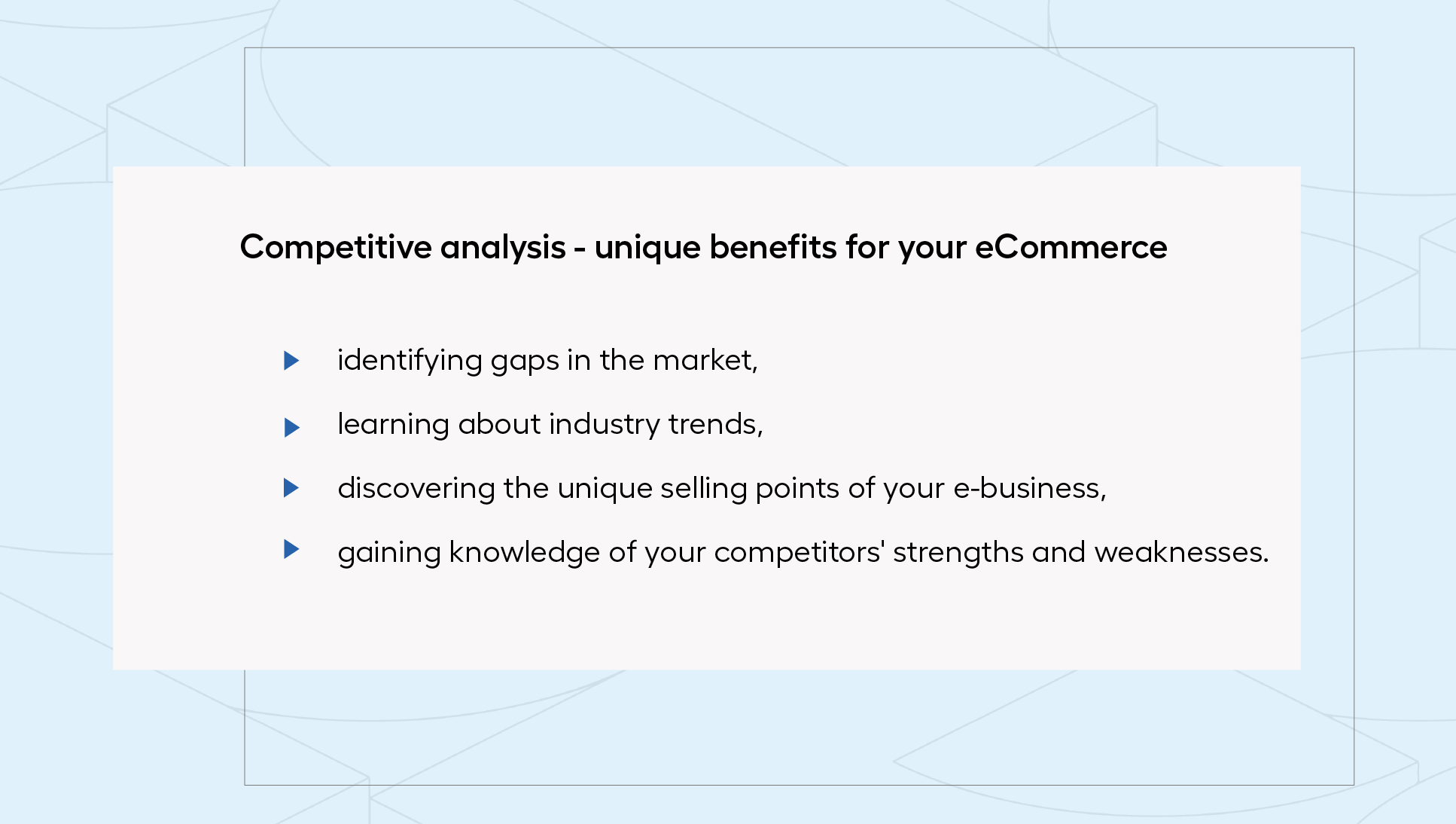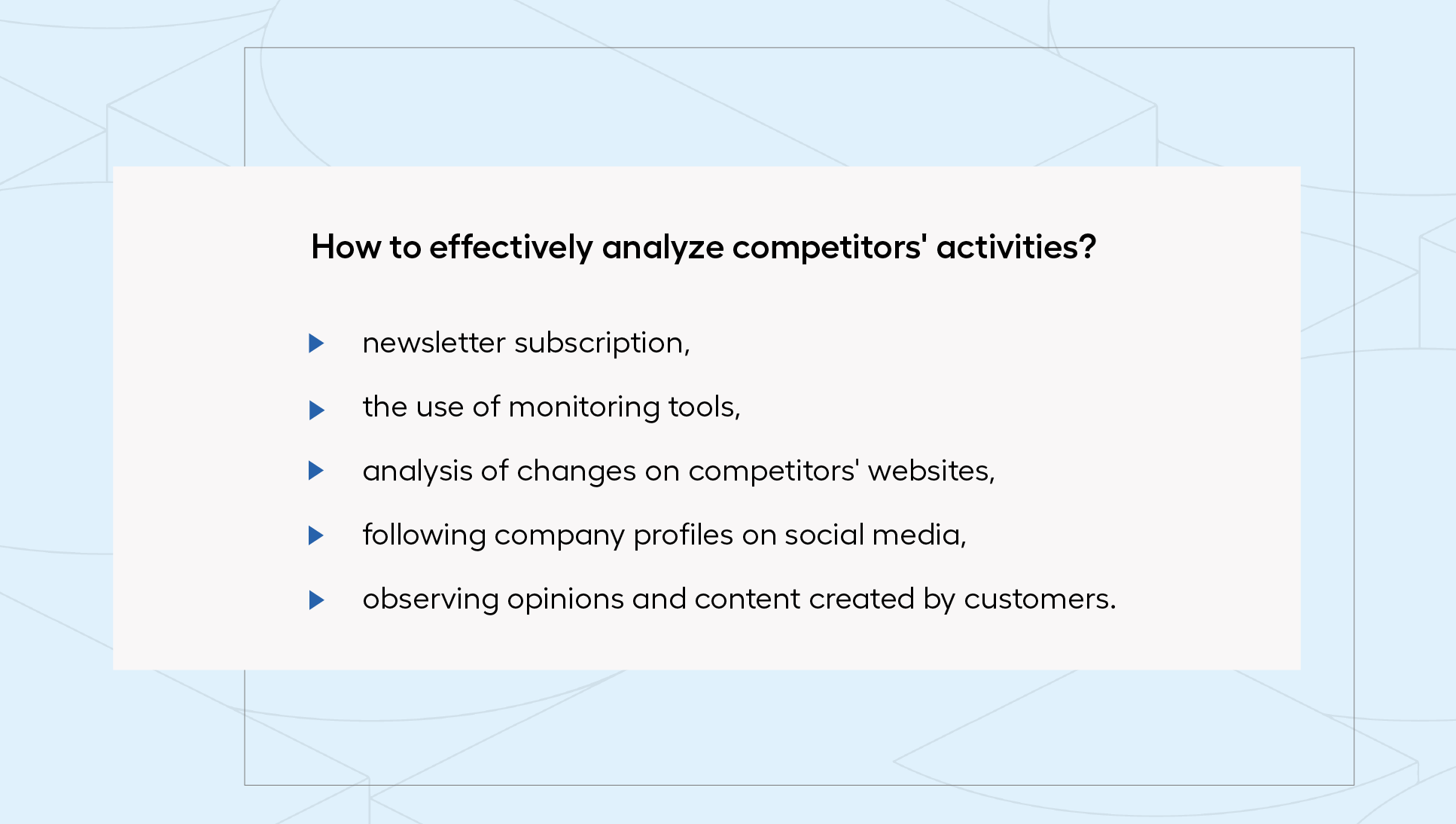Competitor analysis in eCommerce - how to monitor and use competitor information?
When shopping online, customers very often compare available offers, trying to choose the best option for themselves. What matters to any owner or manager of an online store is why the consumer decides to use the offer of store A and not store B, even though the product is very similar and, more importantly, costs exactly the same. Often the answer to this question can be found after conducting a competitive analysis.
Why is monitoring and using competitor information becoming a key factor for stores that want to succeed in eCommerce? We explain in our latest article - feel free to read if you want to learn why and how to do it!
What is competitive analysis in eCommerce?
Competitive analysis in eCommerce involves studying and evaluating the activities carried out by selected competitors. This is how you gain knowledge about their strengths and weaknesses (as a brand, their offerings, etc.) and how they are perceived by your audience. The information gained in this way can provide you with important insights to improve your business strategy - by, among other things, identifying gaps in the market, discovering unique points of advantage, learning about industry trends or opportunities to improve your own offerings. All of these activities are intended to serve one purpose - to build a competitive advantage, which in today's dynamic times in this regard is becoming more challenging every day.

Competitor analysis - what should it include?
It should be pointed out that there are many aspects to consider when monitoring eCommerce competitors. Exactly what elements we will examine as part of our analysis really depends on the nature of our business (especially the industry in which we operate and the characteristics of our target audience, its needs and expectations). Most often, however, we will pay attention to:
USP (ang. Unique Selling Point)
It goes without saying that the competitors' offerings are the starting point in the analysis - after all, every business ultimately comes down to sales, and without a "good product" the results in this regard will not be satisfactory. In this regard, it is therefore worth checking what exactly the competition offers, what forms of delivery and payment it provides (customers often abandon their shopping carts if they do not find their favorite method in the e-store), what practices and elements it tries to attract the interest of customers. Identifying the unique element of the offer - that is, the very USP - will help you improve your own offer and provide a better shopping experience for users.
Pricing strategy
The second important element in the analysis is, of course, the price at which individual products are sold. However, it is not only important what price is currently in effect, but more importantly, what pricing strategy the company is pursuing (what promotions and discounts does it opt for, does it have a loyalty program that allows it to lower the price for selected products, how often does it change the price amount for certain products, which are more expensive, which are cheaper, etc.). Examining this element can be a starting point for a more flexible approach to pricing in your online store and allow you to determine a price that is appropriate (neither too high for the customer nor too low for you).
User experience in an online store
The way an online store is designed translates into a positive or negative user experience. Above all, it influences whether the consumer will stay on the site and get acquainted with the offer, or leave the store, looking for the needed products at competitors. It is for this reason that you should regularly check how the online stores of companies operating in the same industry are designed - especially in terms of the appearance of product cards (photos, descriptions, additional elements, etc.), ease of navigation, available functionality - and on this basis assess what the user experience might be. The next step is to compare the results obtained with the experience gathered from your eCommerce.
When researching competing eCommerce stores, pay attention to how easy it is for customers to find the information they need, make purchases, contact customer service, etc. Also see if your competitors are using personalization or other advanced technologies to improve the customer experience - this can be the USP of some players, especially these days.
Customer reviews
Customer reviews are also a valuable source of competitive information - especially in the case of online shopping, where social proof is important to users. For this reason, it is definitely worth monitoring what both positive and negative comments appear online, which will help you identify the strengths and weaknesses of your competitors' offerings. Analyzing these reviews will allow you to better understand your customers' expectations and adjust your actions to them in improving customer service or the product itself.
Marketing activities implemented
When analyzing your competitors, you should also keep track of the marketing activities they implement to build recognition, increase customer trust and improve sales performance. Above all, they show how competitors engage customers, what their unique selling points are and what industry trends they respond to, as well as what values they want to attract consumers with. In this regard, both organic activities (content shared on social media, press releases, partnerships, etc.) and paid activities (ads, promotional partnerships, sponsorships, etc.) should be monitored - not forgetting possible offline activities (e.g., pop-up stores, customer and influencer events, etc.) to provide direct "live" brand exposure.
SEO activities
It's also worth checking organic search results, examining what the visibility of competitors on the web is, which is important in the area of the SEO strategy we are pursuing. In this regard, it can be particularly valuable to analyze the keywords that companies use in the content on their site, in meta tags, etc. Using the good practices of competing entities, it will be possible to increase your position in Google search in the long term.
How to monitor competitors?
The possibilities for monitoring competitors are almost endless and really depend on the element we most want to study. If we care about information about new events, products or activities, the best way is to subscribe to newsletters (which will allow us to stay up to date) and observe company (and sometimes personal) social media profiles (a monitoring tool such as Newspoint or Brand24 will be helpful in this regard). In the case of customer reviews, you can also check social media (comments, shares, stories, etc.), but also portals created specifically for this purpose (such as Opineo). It's also worth visiting our competitors' sites on a regular basis to monitor what changes have taken place on them, what new articles have appeared, what important press releases have been released, etc.

It will also be a good idea in the area of competition monitoring:
- Conducting a study of our brand recognition with a comparison of our competitors, which will give us a starting point for our next steps (in terms of strengthening or maintaining),
- conducting an NPS (Net Promoter Score) survey of our brand and competitors, which will give us an idea of how customers rate our competitors,
- attending industry events (at which our competitors may also appear as sponsors, speakers, exhibitors, etc.), where you can see first-hand "how the competition works."
- following industry portals where information about the marketing activities of our competitors may appear,
- peeking at competitors' ads (Facebook or Google Ads, for example, allow us to do so), which will allow us to determine what they are focusing on at any given time and perhaps even gain inspiration for our activities.
Monitoring done - and what next?
It is definitely important to emphasize that competitive analysis in eCommerce is not just to "inspect" what other companies are doing and judge from that whether these activities can "threaten" us. It is also supposed to be an opportunity to get inspired, highlight a market trend of importance to us or discover new opportunities for growth in the industry. The information we gather about our competitors should be incorporated into our strategies - keeping in mind, of course, that each brand should pursue its own goals. Thus, one should first of all:
- by identifying unique points of competitive advantage find a similar element in your own business,
- learn from competitors' mistakes and avoid the same pitfalls (e.g., marketing campaigns that have caused black PR about the brand),
- use competitive information to identify gaps in the market and introduce new products or services that meet customer needs.
Competitive analysis in eCommerce - summary
Competitor analysis in eCommerce is an indispensable part of building a successful business strategy. Monitoring the activities of competitors using a variety of methods and tools, and then using the information gathered (to improve products, sales strategy, processes, marketing activities, etc.) allows you to better understand the market, identify unique points of advantage and effectively respond to changes. However, it is important to ensure that competitive analysis is an ongoing (or regularly repeated as in the case of, for example, an online store audit) process, and not performed ad hoc and "on a holiday." Only in this way will it help to maintain competitiveness and achieve success in the dynamic world of eCommerce.



